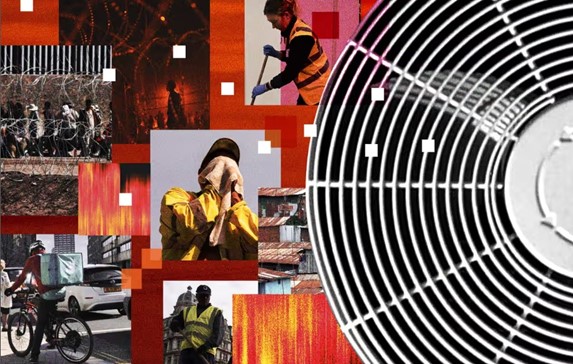
Heat Inequality Leads to Thousands of Unreported Deaths in Poor Nations
Friederike Otto of World Weather Attribution has raised concerns that heat inequality is leading to thousands of unreported deaths in impoverished countries worldwide. As global temperatures soar to levels not seen in 120,000 years, the silent threat of extreme heat is particularly lethal for the economically vulnerable.
"Heatwaves are the deadliest form of extreme weather, yet they don't leave behind visible destruction or dramatic images," said Otto, co-founder of World Weather Attribution and a senior climate science lecturer at the Grantham Institute of Imperial College London. "They claim the lives of poor and isolated individuals in wealthy nations, as well as outdoor workers in developing countries. Over the past 13 months, countless deaths due to extreme heat will go unnoticed and unreported."
This warning comes as global concern about the hidden toll of heat inequality grows. Last month, UN Secretary-General António Guterres issued a call to action on extreme heat, emphasizing the need to protect vulnerable populations and workers exposed to harsh conditions. He highlighted that extreme heat is exacerbating economic disparities, undermining sustainable development goals, and is estimated to cause nearly half a million deaths annually—30 times more than tropical cyclones.
The alarm was raised following the world's three hottest days on record on July 21, 22, and 23. Climatologists believe these temperatures, which exceeded records dating back to 1940, may be the highest in 120,000 years, based on data from tree rings and ice cores. Human activities, such as the burning of fossil fuels, have driven these rising temperatures, contributing to 13 consecutive months of record-breaking heat.
While an exact death toll from these extreme temperatures may never be known, it is clear that low-income groups are disproportionately affected. Heat inequality perpetuates itself, with wealthier individuals enjoying air-conditioned homes, cars, and workplaces, while those less fortunate are left to endure the sweltering heat on the streets as couriers, construction workers, or road cleaners.
The disparity continues at home, with inequality policy adviser Alex Maitland of Oxfam International noting, "Heat-related deaths are shaped by inequality—a heatwave is far more deadly for someone living in a tin shack than for someone in an air-conditioned house."
Over the coming decades, heat-related deaths are expected to rise significantly in low-income countries. The tragic irony is that those who suffer the most from extreme heat are often the least responsible for the rising temperatures. The richest 1% contribute more than two-thirds of global carbon emissions, with their 2019 emissions alone sufficient to cause the heat-related deaths of 1.3 million people.
The suffering extends to religious practices and migration. Over 80% of the 1,300 Hajj pilgrims who died from heat-related causes in June were unauthorized, unable to afford air-conditioned accommodations, and without access to cooling tents and water stations. Many were exposed to temperatures nearing 50°C while staying on the streets.
Studies by World Weather Attribution indicate that climate change has made heatwaves up to 2.5°C hotter, a difference that could mean life or death for many. Asylum seekers, often fleeing heat and drought, are also at higher risk. In June, dozens of Sudanese migrants died from the extreme heat while attempting to cross the border into Egypt illegally. Similarly, three Mexican migrants were found dead in the Sonoran desert in Arizona during a brutal heatwave, with migrant deaths in the El Paso Border Patrol sector more than doubling from 2022 to 2023 due to rising temperatures.
In some developing countries, authorities lack the resources to collect data or investigate individual deaths, particularly in conflict zones such as Afghanistan, Mali, Sudan, Somalia, and the Central African Republic.
Some nations are implementing new laws to protect workers from extreme heat. In Armenia, for instance, special breaks are mandated when temperatures exceed 40°C. Other countries have set varying limits based on the intensity of work, such as Belgium, where thresholds range from 29°C for light work to 18°C for heavy labor. In Cyprus, limits are lower for workers not acclimatized to the heat.
Dr. Halshka Graczyk, an occupational safety and health specialist at the International Labour Organization, noted that productivity declines with each degree increase in temperature. Despite the growing number of temperature regulations, they are often implemented inconsistently, and there is insufficient monitoring to determine their effectiveness in protecting health and productivity.
Enforcing these laws remains a challenge. In Qatar, where outdoor work during the hottest parts of the day is banned from June 1 to September 15, a 2022 investigation found hundreds of violations, particularly in the construction industry.
Otto calls for greater global attention to this largely overlooked crisis. "We simply don't know how many people are dying from extreme heat in poor countries. Given their higher exposure, it's likely the numbers are even greater than in wealthier nations, where thousands of deaths are already documented," she said. Otto urged the media to shift the focus of heat reports from beachgoers to the often-hidden tragedies in marginalized communities, both locally and globally. "Addressing climate change requires tackling inequality both at home and around the world."